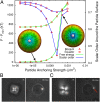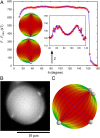Nanoparticle self-assembly at the interface of liquid crystal droplets
- PMID: 25870304
- PMCID: PMC4418874
- DOI: 10.1073/pnas.1422785112
Nanoparticle self-assembly at the interface of liquid crystal droplets
Abstract
Nanoparticles adsorbed at the interface of nematic liquid crystals are known to form ordered structures whose morphology depends on the orientation of the underlying nematic field. The origin of such structures is believed to result from an interplay between the liquid crystal orientation at the particles' surface, the orientation at the liquid crystal's air interface, and the bulk elasticity of the underlying liquid crystal. In this work, we consider nanoparticle assembly at the interface of nematic droplets. We present a systematic study of the free energy of nanoparticle-laden droplets in terms of experiments and a Landau-de Gennes formalism. The results of that study indicate that, even for conditions under which particles interact only weakly at flat interfaces, particles aggregate at the poles of bipolar droplets and assemble into robust, quantized arrangements that can be mapped onto hexagonal lattices. The contributions of elasticity and interfacial energy corresponding to different arrangements are used to explain the resulting morphologies, and the predictions of the model are shown to be consistent with experimental observations. The findings presented here suggest that particle-laden liquid crystal droplets could provide a unique and versatile route toward building blocks for hierarchical materials assembly.
Keywords: defect; interface; liquid crystal; nanoparticle; self-assembly.
Conflict of interest statement
The authors declare no conflict of interest.
Figures








References
-
- Hijnen N, Wood TA, Wilson D, Clegg PS. Self-organization of particles with planar surface anchoring in a cholesteric liquid crystal. Langmuir. 2010;26(16):13502–13510. - PubMed
-
- Loudet JC, et al. Colloidal structures from bulk demixing in liquid crystals. Langmuir. 2004;20(26):11336–11347. - PubMed
-
- Araki T, Tanaka H. Colloidal aggregation in a nematic liquid crystal: Topological arrest of particles by a single-stroke disclination line. Phys Rev Lett. 2006;97(12):127801. - PubMed
-
- Nych A, et al. Assembly and control of 3D nematic dipolar colloidal crystals. Nat Commun. 2013;4:1489. - PubMed
-
- Ravnik M, et al. Entangled nematic colloidal dimers and wires. Phys Rev Lett. 2007;99(24):247801. - PubMed
Publication types
LinkOut - more resources
Full Text Sources
Other Literature Sources

